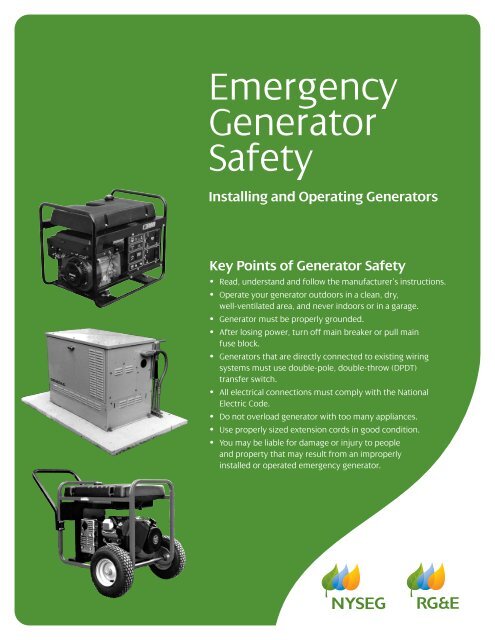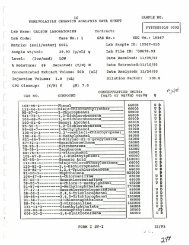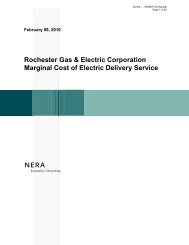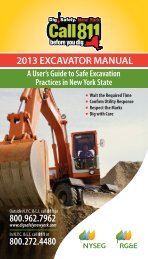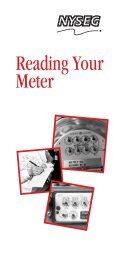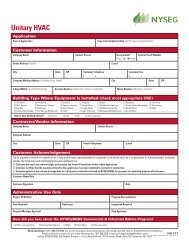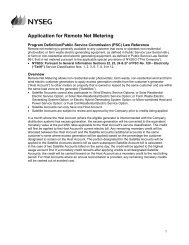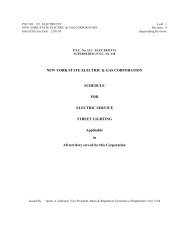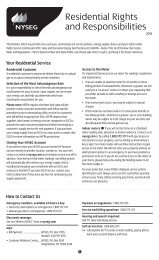Emergency Generator Safety - nyseg
Emergency Generator Safety - nyseg
Emergency Generator Safety - nyseg
- No tags were found...
You also want an ePaper? Increase the reach of your titles
YUMPU automatically turns print PDFs into web optimized ePapers that Google loves.
<strong>Emergency</strong><strong>Generator</strong><strong>Safety</strong>Installing and Operating <strong>Generator</strong>sKey Points of <strong>Generator</strong> <strong>Safety</strong>• Read, understand and follow the manufacturer’s instructions.• Operate your generator outdoors in a clean, dry,well-ventilated area, and never indoors or in a garage.• <strong>Generator</strong> must be properly grounded.• After losing power, turn off main breaker or pull mainfuse block.• <strong>Generator</strong>s that are directly connected to existing wiringsystems must use double-pole, double-throw (DPDT)transfer switch.• All electrical connections must comply with the NationalElectric Code.• Do not overload generator with too many appliances.• Use properly sized extension cords in good condition.• You may be liable for damage or injury to peopleand property that may result from an improperlyinstalled or operated emergency generator.
<strong>Emergency</strong> generatorengines produceexhaust gases thatcontain carbonmonoxide, a colorless,odorless and poisonousgas that can be deadlyin high concentrations.Therefore, generatorsmust be operatedoutdoors and awayfrom any openwindows or areaswhere harmful vaporsmay be trapped.Operate generatorsoutdoors in a clean,dry, well-ventilatedarea, and never indoorsor in a garage. Wet oricy conditions createconsiderable electricshock hazards.You may be liable fordamage or injury toyour neighbors and toNYSEG or RG&E workersand equipment thatmay result from animproperly installed oroperated emergencygenerator. You may alsobe responsible for anyinjury or damage toyour property.This brochure is for our customers who already have, or who plan to buy, an emergency generator.A brief description of generator types and modes of operation is followed by a checklist ofgenerator safety guidelines. The brochure also includes information on sizing a generator to bestmeet your specific needs.All specific questions about generators should be referred to a licensed electrician or your localbuilding code enforcement office.We strongly urge you to consult an electrician prior to installing or operating your generator toensure your safety and compliance with the National Electric Code.OverviewIf you plan on using an emergency generator, it isessential that you take precautions for your safetyand for the safety of NYSEG and RG&E people workingto restore power.During power interruptions, properly sized and installedemergency generators can safely power electricalequipment such as portable heating units, computers,water pumps, milking machines, home freezers,refrigerators and lighting. However, emergencygenerators can be complicated and expensive. The keyin selecting the proper generator is to evaluate whatappliances you really need to power in an emergency.To be safe, read your owner’s manual carefully. Makesure you fully understand the proper installation andoperating procedures for your unit – and don’t forgetto use common sense.<strong>Generator</strong> TypesAvailable as portable or stationary units, generatorscome in many sizes and configurations. However,generators must deliver power at the same voltageand frequency that NYSEG and RG&E provide(120/240-volt, single-phase, 60-cycle alternatingcurrent). <strong>Generator</strong> capacity (size) is usually statedin watts or kilowatts. <strong>Generator</strong>s have one of twodrive systems:• Engine-driven generators are fueled by gasoline,diesel fuel, propane or natural gas. Factors such asavailability, storage, volatility and safety should beconsidered for each fuel type. In general, smallerunits (less than 7,000 watts) tend to be gasolinepowered,while the larger units usually run on dieselfuel, liquid propane or natural gas. NOTE: Manygenerators that are fueled by natural gas require adelivery pressure that is greater than NYSEG’s orRG&E’s standard pressure. If the generator is notsupplied with the manufacturer’s suggested deliverypressure, the generator may not run. Beforepurchasing a natural gas-fired generator, you shouldcontact NYSEG at 1.800.572.1111 or RG&E at1.800.743.2110 to ensure that an elevated deliverypressure is available to your home or business. This isNOT available in all areas.2If an elevated delivery pressure is available, changesto your natural gas service may be required so thatyour generator operates properly. If so, additionalNYSEG or RG&E charges will apply. Also, you will needto purchase and install a pressure-reducing devicefor your other natural gas appliances.NYSEG requires that all natural gas-fired generatorsbe inspected by a certified electrical inspectionagency or local building code enforcement inspector.• PTO-driven generators use a power take-off (PTO)attachment on farm tractors or constructionequipment such as bulldozers and front-end loaders.<strong>Generator</strong>s usually supply either 120 volts or 240 volts,although some models can supply both. <strong>Generator</strong>shave manual or automatic start systems. Manual startsare typical on smaller generators, while automatic startsare common on larger installations. The two safe modesfor supplying power from an emergency generator areas an independent portable operation or an integratedsystem operation.Independent <strong>Generator</strong>sIn this case, the generator operates as an independent,stand-alone unit NOT connected to any existing wiringsystem. Extension cords are plugged into the generatorto deliver power to selected electrical equipment andappliances. Typical setups can range from the small,lightweight, gasoline-powered units to very large,trailer-mounted, diesel-powered generators used inmining and construction.Extension Cord <strong>Safety</strong> TipsSpecific jobs call for specific kinds of extension cords.Since small, independent portable generators rely soheavily on extension cords to distribute power fromthe generator to electrical equipment, it’s good to keepthe following in mind:• Always use properly sized and grounded extensioncords. Check the Underwriters Laboratories (UL) labelon the cord for capacity ratings.• Only use heavy-duty, three-wire grounded cords.Cords used outdoors should be specifically rated foroutdoor use.• Always inspect cords before using them. Use onlycords in good condition to avoid electrical shocks.
• Make sure cords are not a tripping hazard, especiallyin dimly lit doorways or halls.• Never run cords under rugs or carpets where heatmay build up or damaged cords go unnoticed.• An extension cord that is hot to the touch isoverloaded.• Always pull on the plug – not the cord – whendisconnecting it from the wall socket.Integrated System <strong>Generator</strong>sIn this mode of operation, an emergency generatoris connected to an existing wiring system of a home orbusiness using a double-pole, double-throw (DPDT)transfer switch, which safely isolates your generatorfrom NYSEG power lines. According to the NationalElectric Code, this switch must be used whendirectly connecting an emergency generator toexisting wiring.DPDT Transfer SwitchThe DPDT transfer switch (Figure 1) offers protectionagainst dangerous backfeed of electricity from yourgenerator into our power lines, which is a serious riskto customers and to our people working to restorepower. It also minimizes potential fire hazards andother serious damage. Backfeed may make a generatortry to supply load beyond its capacity and thus damageboth the generator and any connected equipment orappliances.The DPDT transfer switch has three positions:• utility power on, generator power off;• both off; and• generator power on, utility power off.The DPDT design guarantees utility power will besafely disconnected before your generator is switchedinto operation.Figure 1.To MainDistributionPanel Box(Main ServiceEntrance)DPDT Transfer SwitchUpNYSEGPower OnBoth OffDown<strong>Generator</strong>Power OnIntegrated System – Permanent <strong>Generator</strong>An integrated system must use a DPDT transferswitch. Figure 2 shows a permanent outdoorgenerator installation, with the unit housed inside aweather-resistant, protective enclosure. The DPDTtransfer switch has been installed between the mainpanel box and a separate emergency sub-panel boxused to redirect generator power to selected circuits.The electric devices you have determined to benecessary in an emergency are wired into theemergency sub-panel.The location of the DPDT switch determines itsrequired current rating (in amps). If the DPDT switch isinstalled on the customer side of the NYSEG or RG&Emeter, it must have a current rating which is equal toutility service (such as 200-amp service). However, ifthe DPDT is installed on the customer side of the maincircuit breaker or fuse panel, then its capacity onlyneeds to match the current rating of the generator(such as 30-amp service).In some cases, generator installations must beinspected to meet the National Electric Code. Checkwith your local building code enforcement officeregarding the need for an electrical inspection andto obtain a listing of approved electrical inspectors inyour area. If you’ve installed an integrated system butare unsure whether you have done it properly, contacta certified electrician or local building codeenforcement inspector.For permanent installations, place the generator onhigh ground where water cannot reach it. Allowsufficient room (3 feet minimum) on all sides of theunit for maintenance and ventilation, and place thegenerator in a location where air inlet and outletopenings will not be blocked by leaves, grass, snowand debris.Integrated System – Portable <strong>Generator</strong>An integrated system using a portable generator isshown in Figure 3. Here, a special heavy-duty cablefrom the generator is plugged into a speciallydesigned outdoor power transfer outlet. (Note: thisis different from a typical outdoor electrical outletfound on most homes.) This outlet feeds the DPDTtransfer switch which, in turn, connects power toselected circuits in the emergency sub-panel box.DO NOT plug anemergency generatordirectly into anelectrical wall outlet byusing a cable made withplugs at each end. THISIS VERY DANGEROUS!Such practice violatesthe National ElectricCode, which clearlystates that such directconnections must bemade using a doublepole,double-throw(DPDT) transfer switchto prevent power beingaccidentally fed backinto NYSEG’s or RG&E’spower lines.Be sure that incomingNYSEG or RG&Epower is completelydisconnected beforeinstalling or usingan integratedsystem generator.<strong>Emergency</strong> generatorsare not intended tobe continuouslyoperated for longperiods of time.To <strong>Emergency</strong>Sub-Panel Box(Selected Circuits)GroundingBlockPower From<strong>Generator</strong>3
Figure 2.Integrated System — Permanent <strong>Generator</strong>For illustration purposes only. We urge you to contact a qualified electrician.Installing an integratedsystem generatoris not a do-it-yourselfjob, as there areconsiderable risksof electrocution. Westrongly recommendusing a licensed,qualified electricianto do the installation.State and localelectrical codes andordinances must bestrictly followed.PowerConnectionFuelSupplyConnectionGroundingRodPermanent<strong>Emergency</strong><strong>Generator</strong>NYSEGor RG&EMeterMainDistributionPanelDPDTTransferSwitchAutomatic Sensing& Transfer Conduit<strong>Emergency</strong>DistributionSub-Panel<strong>Emergency</strong>PowerConduitConcrete PadFigure 3.Integrated System — Portable <strong>Generator</strong> InstallationFor illustration purposes only. We urge you to contact a qualified electrician.NYSEGor RG&EMeterDPDTTransferSwitchOutdoorPower TransferOutletMainDistributionPanel<strong>Emergency</strong>DistributionSub-PanelPortable<strong>Generator</strong>GroundingRod<strong>Emergency</strong>Power LeadsSpecial Heavy-Duty Cable4
Integrated System – Customer-Owned PolesIntegrated system wiring for generators may alsoinvolve connection from a customer-owned utilitypole. Again, a DPDT transfer switch is required and alicensed electrician must make the connections.In this case, the DPDT transfer switch is connected onthe customer side of the meter and therefore musthave current rating to match utility service.A general arrangement is shown in Figure 4.In such an arrangement, NYSEG and RG&E provideselectricity service to the weatherhead (connection tohouse or pole) and the meter.The customer is responsible for providing: service rack,meter socket, pressure-treated utility pole, groundwires and grounding rods, DPDT transfer switch,generator plug, conduit, electric wire, guy wires and allother associated hardware.The customer also must install the pole, guy, DPDTtransfer switch, the meter socket or enclosure, theconduit between them (if used), the grounds andgrounding conductor, and make other connectionsas required on the load side only. NYSEG or RG&E willinstall meter.NOTE: The pole must be pressure preservative treated.A brochure containing guidelines and specificrequirements on the installation of customer-ownedpoles can be found at <strong>nyseg</strong>.com or rge.com (click on“Brochures,” “For your home” or “For your business,”and then “Specifications for Customer Electric Service,2,400 to 34,500 volts (SP-1099)”). Or call NYSEG at1.800.572.1111 or RG&E at 1.800.743.2110 and we’ll sendyou a copy.Figure 4.NYSEG orRG&E ServiceDPDT Transfer Switch from Customer-Owned PoleFor illustration purposes only. We urge you to contact a qualified electrician.ServiceRack orClevis24"10"Locate neutral accordingto local practiceMultiplex wiresare acceptableToCustomerLoadElectrician to makeconnections on loadside onlyDPDTTransfer SwitchNote: DPDT must havecurrent rating (amps)equal to utility service.NYSEGor RG&EMeterHandle to beGroundedGroundingRodMale Plugto <strong>Generator</strong>Ground Wire #4 BareCopper UnderProtective CoverGroundingRod3'-0" MIN3'-0" MIN2 Grounding Rods requiredas shown 5/8" x 8' copperweldor galvanized rods5
Sizing an <strong>Emergency</strong> <strong>Generator</strong>Prioritize your needs before buying a generator. Makea list of all critical items you feel must operate in anemergency. Electrical appliances have resistive orinductive load. Resistive load appliances (electricstoves, electric space heaters, radios, light bulbs,televisions) have the same starting and operatingwattages. For example, a 100-watt light bulb requires100 watts. Inductive load appliances (power tools,refrigerators, freezers, pumps) use electric motorsthat require two to four times the operating wattagefor start-up.For example, an appliance with an electric motor mayneed one kilowatt to run, but two to four kilowatts toget started. Without sufficient starting power, motorsmay overheat, fail to run or burn out the generator’scircuit breaker. Here are some tips on load planning:• Use low-wattage light bulbs that provide a safe levelof light. This reserves power for additional lighting,small equipment or appliances.• Limit the load on your generator. Higher loads usemore fuel.• Add the wattages of essential appliances, including“starting wattage” for items that use electric motors.• Nameplate information on motors or appliances canhelp you determine their kilowatt rating.• Power (watts) = Current (amps) x Voltage (volts)• Do not exceed the capacity of your generator.The table on the back of this brochure providestypical wattages for some residential and farmequipment and includes a worksheet for planning loadrequirements. If you are buying a generator, thisinformation may help you size it to fit your individualneeds. We strongly urge you to consult with anelectrical contractor or dealership that sells andservices emergency generators. This will help ensuresafe operation and compliance with the NationalElectric Code. The following examples use this data:Appliance/Equipment OperatingExample 1Customer intends to provide standby power to all the equipment necessary in an emergency situation. Major itemsinclude water well pump, hot water heater, natural gas furnace and some auxiliary heating. Based on thesecalculations, this customer will need a 15,000-watt generator.Appliance/Equipment Wattage Starting Wattage No. of Items Total WattageLight Bulbs (60-watt) 60 60 4 240Light Bulbs (100-watt) 100 100 2 200Water Well Pump (1/2 horsepower) 1,000 2,100 1 2,100Hot Water Heater 4,500 4,500 1 4,500Portable Space Heater (5,000-Btu) 1,350 1,350 1 1,350Gas Furnace Fan (1/4 horsepower) 600 1,000 1 1,000Heat Tape (30-foot water pipes) 240 240 1 240Refrigerator/Freezer 700 2,200 1 2,200Microwave Oven (625-watt) 625 800 1 800Toaster Oven 1,500 1,500 1 1,500Radio 75 75 1 75Digital Clock 2 2 1 2Total Load 14,207As a reminder,always assume thatdowned or brokenwires are live. Stayaway from them andcall our electricemergency numberimmediately (NYSEG at1.800.572.1131 or RG&Eat 1.800.743.1701). If aperson is in contactwith a live wire, do nottouch or try to movethat person until theline is de-energized.You may be liable fordamage or injury toyour neighbors and toNYSEG and RG&Eworkers and equipmentthat may result from animproperly installed oroperated emergencygenerator. You may alsobe responsible for anyinjury or damage toyour property.Example 2Customer intends to purchase a 5,000-watt portable generator. Customer begins planning by first loading up themost critical equipment, working backward by adding devices to stay under the unit capacity.Appliance/Equipment Operating Wattage Starting Wattage No. of Items Total WattageLight Bulbs (60-watt) 60 60 4 240Light Bulbs (100-watt) 100 100 2 200Portable Space Heater (5,000-Btu) 1,350 1,350 1 1,350Refrigerator/Freezer 700 2,200 1 2,200Microwave Oven (625-watt) 625 800 1 800Radio 75 75 1 75Digital Clock 2 2 1 2Total Load 4,8677
Typical Electrical Appliance WattagesFor Selected Home and Farm EquipmentDetermine Your Own Electrical NeedsOperating Starting Typical Number ofElectrical Appliance or Load Device Wattage Factor Device Wattage Connected Devices Total Wattage NeededHome Comfort & SecurityLight Bulb (60-watt) 60 1.0 60Light Bulb (100-watt) 100 1.0 100Flood Lamp (Halide, 400-watt) 400 1.0 400Water Well Pump (1/2 horsepower) 1,000 2.1 2,100Submersible Sump Pump (1/2 horsepower) 1,050 2.0 2,150Hot Water Heater 4,500 1.0 4,500Portable Space Heater (5,000-Btu) 1,350 1.0 1,350Central Air Conditioner (24,000-Btu) 3,800 1.3 4,950Gas/Fuel Furnace Fan (1/4 horsepower) 600 1.7 1,000Garage Door Opener (1/4 horsepower) 750 2.5 3,000Heat Tape (30-foot water pipes) 240 1.0 240Food Storage & PreparationRefrigerator/Freezer 700 3.1 2,200Electric Range & Oven 10,000 1.0 10,000Microwave Oven (625-watt) 625 1.3 800Toaster Oven 1,500 1.0 1,500Coffee Maker (drip) 1,100 1.0 1,100Power ToolsWashing Machine (without hot water) 1,150 2.0 2,300Clothes Dryer (electric) 5,000 2.4 12,000Dishwasher (cool dry) 700 2.0 1,400Electric Blanket 400 1.0 400Communications & RecreationPersonal Computer with Monitor 200 1.0 200Television (color) 300 1.0 300Videocassette Recorder/Player 30 1.0 30Stereo (tuner, CD, tape, speakers) 100 1.0 100Radio 75 1.0 75Digital Clock 2 1.0 2Power ToolsCircular Saw (7 1/4-inch) 1,400 1.6 2,300Reciprocating Saw 750 1.9 1,400Table Saws (10-inch) 1,800 2.5 4,500Hand Drill (3/8-inch) 400 1.0 400Air Compressor (1 horsepower) 1,500 3.0 4,500DC Battery Charger (12-volt) 100 1.0 100Farm & Dairy EquipmentMilking Machine 4,200 3.0 12,600Bulk Milk Cooler 10,500 3.0 31,500Barn Water Heater 9,000 3.0 27,000Ventilation Fans 500 3.0 1,500Silo Unloader 5,500 3.0 16,500Gutter Cleaner 2,000 3.0 6,000Total Wattage NeededNYSEG 12-0121© 2012 New York State Electric & Gas Corporation


